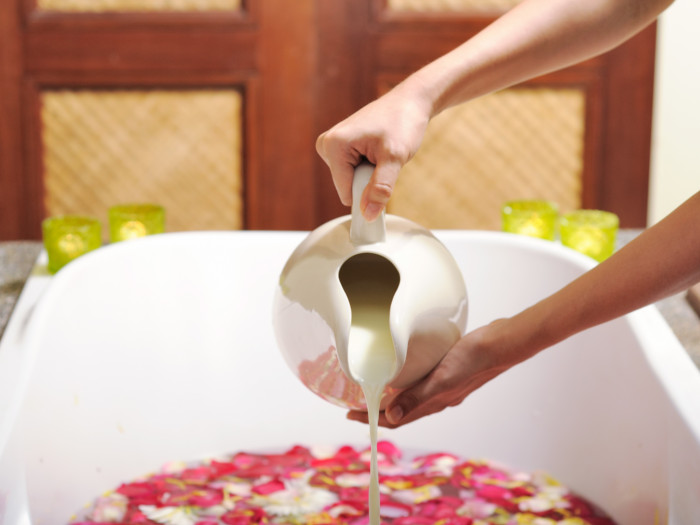You may have read about the beauty secrets of ancient queens and princesses. They swore by milk baths and the things it could do for the skin. Fast forward to today, researchers and beauty experts around the world are praising the milk bath and for a good reason. Taking a milk bath can help exfoliate, moisturize, and revitalize the skin, while also being a soothing and relaxing experience!
What is a Milk Bath?
A milk bath is an ancient practice that consists of bathing with milk and many other natural ingredients like flower petals. According to various studies, Cleopatra, the ruler of ancient Egypt, is said to be the first to use this technique to improve the complexion of her skin. The practice of milk bathing is also attributed to medieval-era British royalty. In the present day, the lactic acid present in milk has been shown to be a gentle exfoliant, loosening dead skin, while the milk fat provides moisture that your skin needs to look and feel healthy. [1] [2]

A milk bath can help improve the skin glow. Photo Credit: Shutterstock
Health Benefits of a Milk Bath
Most of the benefits of milk bathing are skin-related, but they can also help with uplifting your mood.
- Exfoliation: This is the process of removing old or dead skin cells. While exfoliating usually means using an abrasive scrub or brush, or chemical treatment, such as a chemical peel, the lactic acid in milk gently breaks apart the bonds between skin cells and allows exfoliation without harsh methods, according to research. This is especially beneficial for those with sensitive skin. [3]
- Soothing Irritated Skin: Those with eczema, psoriasis, rashes, or other skin irritations often find relief from their uncomfortable conditions with milk baths. Milk can reduce both irritation and inflammation that is commonly caused by these ailments.
- Moisturizing Skin: The milk fat acts as a natural skin moisturizer. Especially in arid or cold climates, regular milk baths can help keep the skin from drying out, which lowers your risk of other skin conditions or afflictions.
- Better Appearance: The exfoliation of dead skin cells can stimulate the generation of new cells, which can result in more youthful-looking skin. Additionally, your skin will feel softer after milk baths as well.
- Relaxation and Stress Reduction: According to Lynn Keegan from the Alternative and Complementary Modalities for Managing Stress and Anxiety, if used with soothing herbs and oils, warm milk baths can relax the muscles of the body, and the time spent in the bath allows for mental relaxation and stress relief. [4]
Types of Milk You can use
You can use any type of milk that you wish to.
- Cow milk is the most used milk as it is inexpensive and also available in most of the places.
- Goat milk is also treasured for its skin-enriching properties so you can use that to draw a bath.
- Soy milk is great for people worried about allergies or lactose intolerance.
- If you are a vegan, then you can use almond, cashew or even coconut milk.
How to Prepare a Milk Bath?
While the milk baths of historic royalty consisted entirely of milk, using only a small amount of milk is enough to enjoy the benefits.
- Step 1: Begin to fill the bathtub with warm water, and while the water is running, mix in two cups of high-fat, high-lactose milk, such as whole milk or goat’s milk. Use an extra cup if the bathtub is exceptionally large. Alternatively, one cup of powdered milk can be substituted.
- Step 2: Stir the milk until it is uniformly mixed.
- Step 3: Adding a few drops of essential oil, and/or a few sprigs of therapeutic herbs, such as lavender or rose hips, can enhance the aromatic experience of the milk bath. You can also add honey. There are many bath milk bases, which are often premixed with herbs and oils, so you can use those.
- Step 4: A soak of 15 to 20 minutes once a week is usually enough to begin to see the benefits for your skin.
- Step 5: Once you are finished bathing, rinse off in the shower to wash away the milk and any exfoliated skin.
- Step 6: Use lotion after rinsing and drying to maximize the moisturizing benefits!
Note: While vegan milk, such as coconut or almond, may have some moisturizing benefits, the lactic acid required to exfoliate the skin is not present in non-dairy milk.
How safe are Milk Baths?
- For most of the population, a milk bath is a doable regime but people with sensitive skin should definitely do a patch test.
- If you are allergic to milk, then make sure to avoid it.
- If you are suffering from illness or fever, then consider keeping away from fancy baths like a milk bath.
- The milk and water mixture that you use for the bath is inedible so make sure you do not consume it.
Happy bathing!
